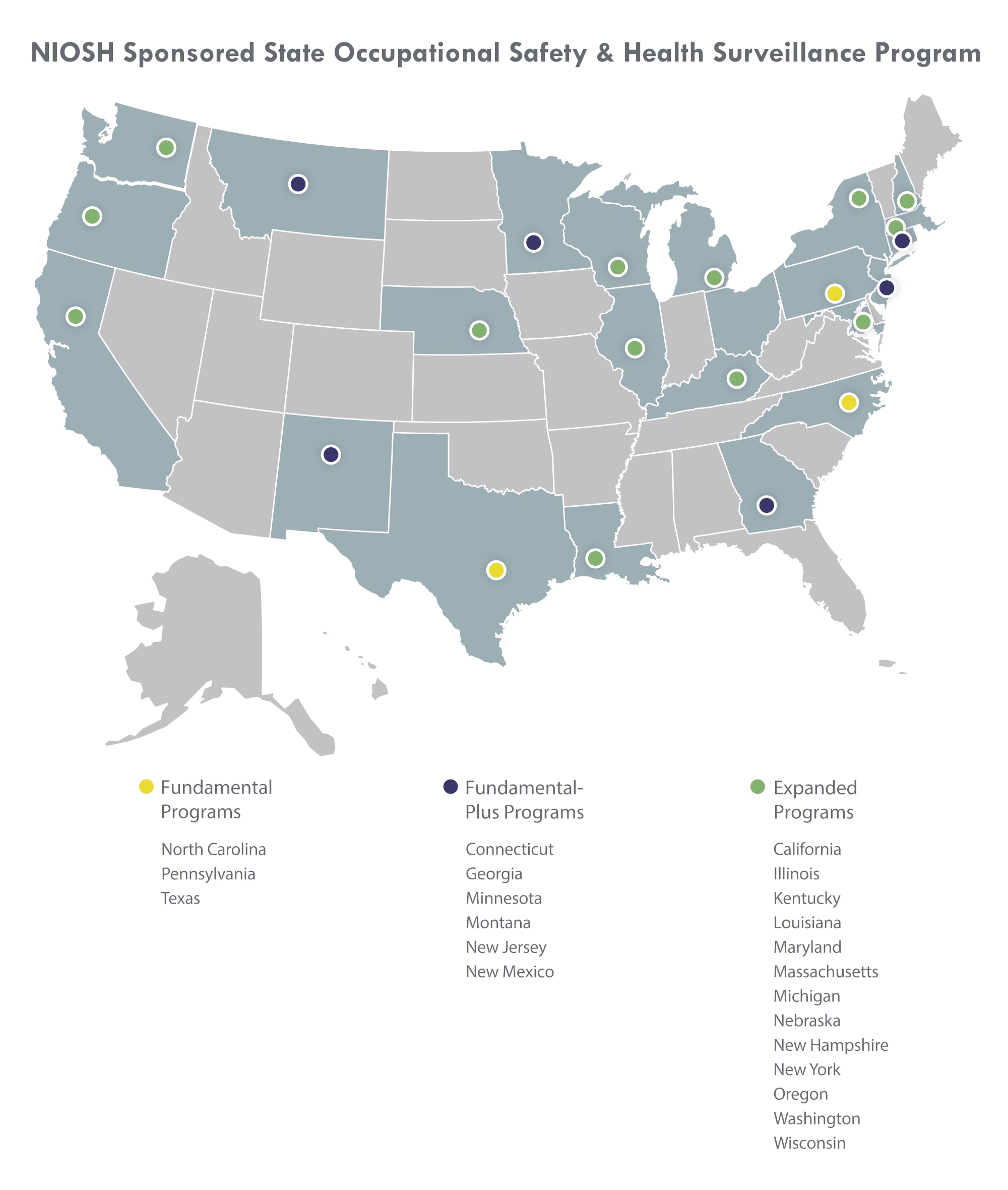Key points
- NIOSH funds 23 states to conduct occupational safety and health surveillance.
- All funded states conduct fundamental surveillance activities. Many funded states receive funding support for additional activities.

Overview
Making workplaces safer and healthier begins with having the data necessary to understand the problem. NIOSH funds states and other jurisdictions to conduct occupational safety and health surveillance.
This data helps us better understand the incidences of job-related injuries, illnesses, exposures, and fatalities. It also helps us identify trends, and emerging issues, especially in high-risk worker populations. The programs engage in outreach and education, in partnership with public health and safety practitioners to advance “data into action.”
Programs

NIOSH currently funds 23 states: four Fundamental, six Fundamental-Plus, and 13 Expanded Programs. The programs are managed by 13 state health departments, two state Departments of Labor, and eight bona fide agents. Bona fie agents are partnerships between state health departments and universities.
Fundamental
Fundamental Programs establish and maintain "fundamental" OSH surveillance capacity and conduct specific activities. This includes collecting, analyzing and interpreting at least 15 out of 24 Occupational Health Indicators annually. NIOSH funds fundamental programs in North Carolina, Pennsylvania, Tennessee, and Texas.
Fundamental-Plus
Fundamental-Plus Programs conduct all fundamental activities plus: 1) in-depth analysis or follow-up investigations and 2) a policy or intervention activity. NIOSH funds Fundamental-Plus Programs in Connecticut, Georgia, Minnesota, Montana, New Jersey, and New Mexico.
Expanded Program
Expanded Programs conduct all fundamental activities, plus in-depth surveillance activities in up to four priority areas of their choosing. NIOSH funds Expanded Programs in California, Illinois, Kentucky, Louisiana, Maryland, Massachusetts, Michigan, Nebraska, New Hampshire, New York, Oregon, Washington, and Wisconsin.
Accomplishments
COVID-19 Projects
State-based surveillance was critically important during the COVID-19 pandemic. In FY 2021, 15 states requested and received funding for 26 projects focused on either or both of two areas:
- Worker safety and health support, safe return to work policies, and mitigation or prevention of COVID-19 outbreaks in various industry sectors.
- Strengthening vaccine confidence in workers
Clearinghouse
States voluntarily participate in the State-based Occupational Health Surveillance Clearinghouse. It is a searchable collection of workplace safety and health materials produced and shared by state programs.
Spotlight
State programs also support specific types of surveillance through their fundamental and supplemental activities:
Fatal injury - Eight funded states participate in the NIOSH Fatality Assessment and Control (FACE) program. These states study fatal workplace injuries and prepare reports with recommendations to prevent similar deaths.
Lead exposure - Thirty-seven states participate in the NIOSH Adult Blood Lead Epidemiology and Surveillance (ABLES) program. The goal is to reduce elevated blood lead levels among working adults 16 years and older.
Pesticide injury and illness- Thirteen states participate in the Sentinel Event Notification System for Occupational Risk (SENSOR)-Pesticide program. The program was developed to examine over-exposure to pesticides in the workplace and prevent these exposures from happening.
Respiratory disease -To support occupational respiratory disease surveillance, all funded states collect data on pneumoconiosis and work-related asthma. Four states also carry out additional surveillance on work-related asthma. Four states do additional surveillance on silicosis.
Funding sources
The cooperative agreement for the state-based surveillance programs runs in five-year cycles. The current cooperative agreement under PAR-20-312 has a project cycle from 2021-2026. Previously, NIOSH funded Centers from 2015-2020 under PAR-14-275.
NIOSH also funds a companion coordinating center award to the Council for State and Territorial Epidemiologists (CSTE) through RFA-OH-23-002. The project period is 2023-2028.
